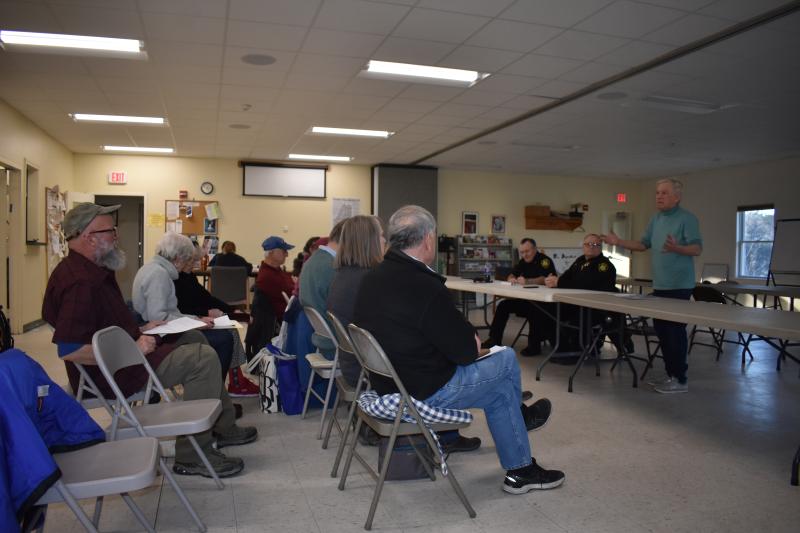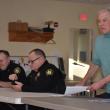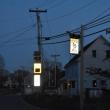ST. GEORGE — Steve Cartwright wants to start a campaign. Distribute information, design a logo, create clever sayings that will get into peoples heads, create some enthusiasm.
“I’m very fond of the idea of having a slogan, like ‘Slow Down St. George’ and starting an actual campaign to get people to slow down,” said Cartwright. “We’ll never get 100%, but if we get even a dent in it, that’s good.”
His initial public meeting, Feb. 8, 2024, to discuss speeding along St. George roadways produced a modest crowd of 11 (vocal) residents, yet support by many others has channeled its way to him via emails, conversations, similar anecdotes of dangerous odometers. Cartwright is a big fan of creative signs, yet his audience was more keen on options that put more control in their collective hands, and that drivers wouldn’t stop seeing after awhile.
As one resident said: “I would hate to see a committee that just sits around and talks about all of the problems, that doesn’t come forward with some sort of plan to address these things.”
Attendees began brainstorming solutions, bouncing questions off of Knox County Sheriff’s Office members Chief Deputy Curt Andrick and Patrol Capt. Paul Pinkham, and lofting ideas at Cartwright, a town Select Board member who, years ago, helped bring a traffic light to Waldoboro’s Route 1 intersection in front of Moody’s Diner while he participated in that town’s government. Though the lively St. George discussion lasted an hour, solutions are still an ad hoc committee and several meetings away, with road blocks at a few strategic intersections: Maine Department of Transportation needs to approve anything that concerns State roads, State representatives often need to encourage MDOT involvement or to change State policies, and all ideas – State or Town – require taxpayer money.
Therefore, a second meeting will be announced after Cartwright synchronizes a date when a State representative and an MDOT representative can be in attendance. The KCSO would also like to attend, if available.
One man at the meeting spoke of his fear for life in backing out of his driveway onto a major road. A woman no longer walks on the Kinney Woods Road after almost being hit on multiple occasions. Others spoke of large construction vehicles and the perception, or reality, of speed that comes with large volume, high momentum mass. Hasty tourists en route to the Port Clyde dock received some spotlight. Distracted driving slipped in, and acknowledgment followed that some people are going to speed, no matter what.
Basically, all roads within the town are subject to complaints, though Route 131, Wiley’s Corner, and Marshall’s Point were mentioned specifically, as well as a crosswalk in front of a post office that doesn’t even lead to a sidewalk on the other side. Or, in another case, a certain road (Kinney Woods), once unpaved, now a “racetrack.”
Sign placement is a factor (hidden by tree branches in one location) and sign size is another. The large one that keeps returning to the Welcome to Tenants Harbor village line (not approved by MDOT), is a size that residents like. So why not make the other signs that big?
Some residents suggested putting speed limit signs farther ahead of village signs so that drivers have more time to slow down.
Residents are noticing slower traffic on Main Street (Route 131) through the school zone, across from the Town Office in Tenants Harbor. A new neon speed sign is enhanced by flashing lights. However, those lights are only during certain hours of the day and months of the year. To put those types of flashing signs elsewhere might work for awhile, according to Andrick, but after awhile, people no longer see them.
One person dreamed of a similar tactic to modern tollbooths. Create speed signs that take pictures of license plates, then send a bill to the owner.
That won’t work, but Andrick suggested another option: dynamic flashing radar signs. KCSO has one. They keep it on a trailer. When asked if drivers will only speed up again when the radar sign is removed, Andrick said: “to some extent. I think it’s a reminder – if you are driving along and not paying attention, and there’s a flash, and it shows your speed – generally most people are going to slow down.”
Whereas village roads are under Town control, these are the easier locations to act on solutions, according to Andrick and Cartwright. Cartwright, himself, suggested that, in village areas, have sidewalks that extend wider into the street, narrowing the roadway and forcing passing vehicles to slow down.
What does a village connote? asked one resident: pedestrians, dogs, activity. How about seasonal speed bumps in the Marshall’s Point vicinity, which is a favorite walking location for some people? To install permanent speed bumps will cause problems with snow plowing, said another. Speed humps (wider, flatter strips of raised pavement) are expensive.
If nothing else, educate local companies to slow down, and have their visitors do the same.
One resident offered an anecdote from a different time in his life when a “constable bullied him” for speeding. The experience left the man permanently deterred from disobeying the speed limit, and feels that constables should continue to put that pressure on with all speeders.
Regardless of law enforcement temperament, the first need is for available deputies. An option suggested by Andrick was for St. George to occasionally hire an off-duty deputy for a speed detail at specific zones for a few hours. This is done by other Knox County towns from time to time, with fair success – within those hours. It’s admitted that deputies cannot be there 24/7, and therefore speeds may increase again later in the day. But, something is still better than nothing.
There’s that military mentality as well. There are two ways to make people do something, said one resident. Wave the carrot or the stick.
“Unless St. George is going to invest a police department that’s down here 24/7 writing tickets….,” he said. “We don’t have a police presence down here. You can put up all the speed limit signs you want, but nobody’s going to pay attention to them. You’ve got to have a stick.”
Andrick, however, was quick to say that it’s not a matter of two needs, but a matter of three needs: enforcement, education, signs. He reminded the residents that Federal grants are sometimes available, and village areas are not in MDOT domain.
“A lot of things that you talked about are in your control,” said Andrick.
Reach Sarah Thompson at news@penbaypilot.com



































